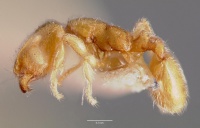Carebara longii
| Carebara longii | |
|---|---|

| |
| Scientific classification | |
| Kingdom: | Animalia |
| Phylum: | Arthropoda |
| Class: | Insecta |
| Order: | Hymenoptera |
| Family: | Formicidae |
| Subfamily: | Myrmicinae |
| Tribe: | Crematogastrini |
| Genus: | Carebara |
| Species: | C. longii |
| Binomial name | |
| Carebara longii (Wheeler, W.M., 1903) | |
This is the only North American species of Carebara, collected in Texas. Wheeler provides description of workers, females and males and offered some biological notes. The description was “[based] from numerous workers and males and four females from Denton, Texas” (Wheeler, 1903:145) and is interesting that the samples collected by Mr. Long were devoid of major workers. C. longii were until now put in the genus Oligomyrmex, and is intriguing the lack of soldiers in a genus, Oligomyrmex, normally characterized by the presence of dimorphic workers. Perhaps the soldiers were not collected or they are truly absent in this species.
Identification
A member of the Carebara concinna species complex.
Keys including this Species
Distribution
Latitudinal Distribution Pattern
Latitudinal Range: 33.21667° to 9.4817844°.
| North Temperate |
North Subtropical |
Tropical | South Subtropical |
South Temperate |
- Source: AntMaps
Distribution based on Regional Taxon Lists
Nearctic Region: United States (type locality).
Distribution based on AntMaps
Distribution based on AntWeb specimens
Check data from AntWeb
Countries Occupied
| Number of countries occupied by this species based on AntWiki Regional Taxon Lists. In general, fewer countries occupied indicates a narrower range, while more countries indicates a more widespread species. |

|
Estimated Abundance
| Relative abundance based on number of AntMaps records per species (this species within the purple bar). Fewer records (to the left) indicates a less abundant/encountered species while more records (to the right) indicates more abundant/encountered species. |

|
Biology
Castes
Worker
Images from AntWeb
   
| |
| Cotype of Carebara longii. Worker. Specimen code casent0103523. Photographer April Nobile, uploaded by California Academy of Sciences. | Owned by USNM, Washington, DC, USA. |
  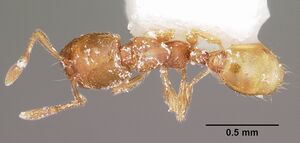 
| |
| Worker. Specimen code casent0104651. Photographer April Nobile, uploaded by California Academy of Sciences. | Owned by UTEP, El Paso, TX, USA. |
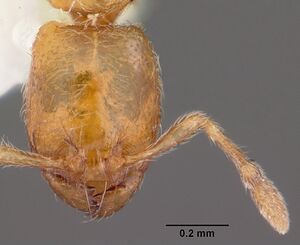   
| |
| Worker. Specimen code casent0104652. Photographer April Nobile, uploaded by California Academy of Sciences. | Owned by UTEP, El Paso, TX, USA. |
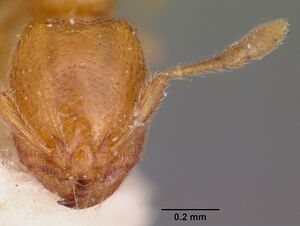 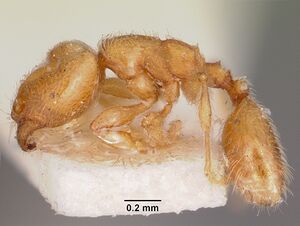 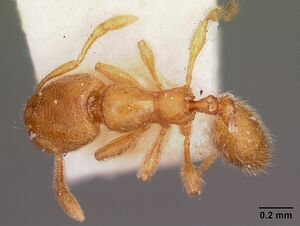 
| |
| Worker. Specimen code casent0104661. Photographer April Nobile, uploaded by California Academy of Sciences. | Owned by AMNH, New York, NY, USA. |
Queen
Images from AntWeb
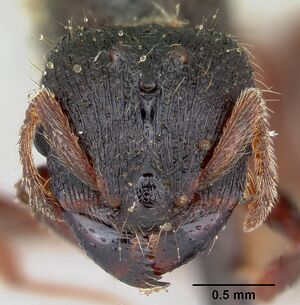    
| |
| Queen (alate/dealate). Specimen code casent0103521. Photographer April Nobile, uploaded by California Academy of Sciences. | Owned by USNM, Washington, DC, USA. |
  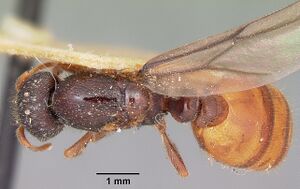  
| |
| Queen (alate/dealate). Specimen code casent0104659. Photographer April Nobile, uploaded by California Academy of Sciences. | Owned by AMNH, New York, NY, USA. |
Male
Images from AntWeb
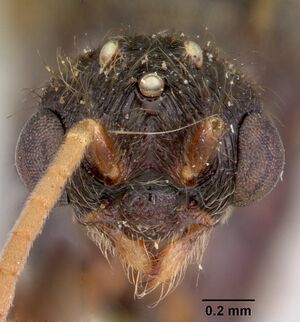   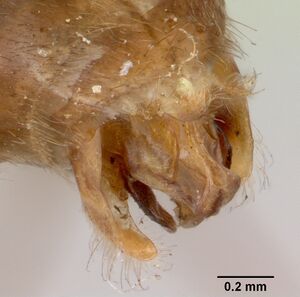 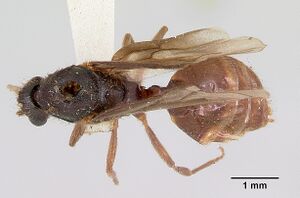 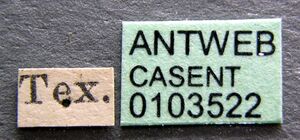
| |
| Male (alate). Specimen code casent0103522. Photographer April Nobile, uploaded by California Academy of Sciences. | Owned by USNM, Washington, DC, USA. |
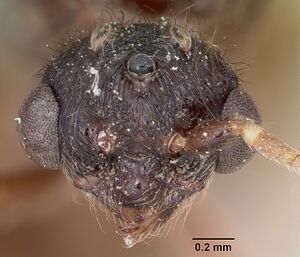  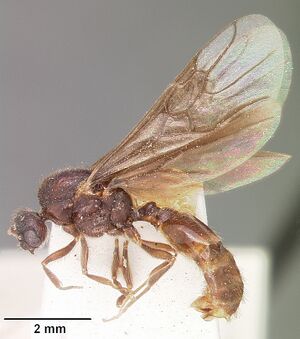  
| |
| Male (alate). Specimen code casent0104660. Photographer April Nobile, uploaded by California Academy of Sciences. | Owned by AMNH, New York, NY, USA. |
Nomenclature
The following information is derived from Barry Bolton's Online Catalogue of the Ants of the World.
- longii. Erebomyrma longii Wheeler, W.M. 1903a: 140, figs. 1-5 (w.q.m.) U.S.A. (Texas).
- Type-material: lectotype worker (by designation of Fernández, 2004a: 199), paralectotype workers, paralectotype males (numbers not stated, “numerous”), 4 paralectotype queens.
- Type-locality: lectotype U.S.A.: Texas, Denton County, Denton, 28.ix.1902 (W.H. Long); paralectotypes with same data.
- Type-depositories: MCZC (lectotype); AMNH, LACM, MCZC (paralectotypes).
- Combination in Oligomyrmex: Ettershank, 1966: 123; Bolton, 1995b: 299;
- combination in Carebara: Fernández, 2004a: 199.
- Status as species: Wheeler, W.M. 1908e: 423; Wheeler, W.M. 1910g: 563; Emery, 1924d: 219; Creighton, 1950a: 246; Smith, M.R. 1951a: 815; Wilson, 1962a: 63; Ettershank, 1966: 123; Smith, M.R. 1967: 358; Wilson, 1986b: 61; Smith, D.R. 1979: 1390; Bolton, 1995b: 299; Fernández, 2004a: 199 (redescription).
- Distribution: U.S.A.
Unless otherwise noted the text for the remainder of this section is reported from the publication that includes the original description.
Description
Worker
Fernández (2004) - Lectotype (here designated): HW 0.48 HL 0.60 SL 0.32 PW 0.29 WL 0.55 GL 0.64 TL 2.13 CI 79 SI 68.
Head slightly longer than wide. Posterior border concave, lateral sides slightly convex. Mandibles with 4 teeth. Palps 2,1 (Wheeler 1903). Median portion of clypeus slightly concave. Sides of median portion of clypeus narrowing onto frontal lobes. Frontal triangle poorly defined, best seen in dorsal oblique view. Eyes reduced to one ommatidium, situated anterior to cephalic midline. Antennae 11-segmented with club 2-segmented. Scapes fail to reach the vertexal border in 1/3 of the head length. In side view, alitrunk slightly convex, interrumped by the deep metanotal groove. Promesonotal suture impressed laterally. Mesonotal groove deep and well marked dorsal and laterally. Propodeum armed with small teeth which is hardly longer than broad. Propodeal spiracle relatively small, circular, high and equidistant from base of tooth. Bulla of metapleural gland large. Propodeal lobes reduced to narrow lamellae extended from propodeal tooth downward. Petiole with short peduncle and with well defined, high node; petiolar spiracle at midway of petiolar length. Subpetiolar process produced as strong spine directed forward, spine normally not visible in mounted specimens. Postpetiole dorsally concave, lower than petiole. In dorsal view petiole longer than broad and longer than postpetiole. Postpetiole broader than longer and broader than petiole, and campanuliform in posterior oblique view. In dorsal view anterior margin of first tergum straight. Basal portion of first tergum with a shallow cuneate trench. Body smooth and shining. Mandibles with several coarse scattered punctures interspersed with irregular longitudinal carinae feebly impressed. Head densely puncturated (except in the central longitudinal area), each punctum with a small hair. Anterior half of head with a few fine longitudinal rugulae, concentric around antennal receptacles. Sides of alitrunk (except pronotum) and petiole densely rugoso-reticulated, sometimes the sculpturation poorly defined. Short curved hairs (less than 0.04 mm) on head, antennae, mandibles, legs, promesonotum, a few in petiole. Four medium size hairs (about 0.05 mm) on median portion of clypeus. Large hairs (more than 0.07 in length): Four arising from the anterior clypeal margin proyected upward (the external ones) and forward (the internal ones) approaching the mandibular apices; two near the occipital border and one over occipital border, two near the pronotal humeri, two in the promesonotal dorsum, near the posterior margin; several on petiolar and postpetiolar dorsum. All body yellowish.
Very similar to the male of Carebara longiceps.
Male
Fernández (2004) - Male paralectotype (here designated, LACM): HW (including eyes) 1.13 HL 0.84 EL 0.41 SL 0.23 PW 1.25 WL 1.25 WL 5.2 GL 2.95 TL 10.11 CI 134 SI 20.
Type Material
Fernández (2004) - Paralectotype (here designated). UNITED STATES. Texas: 3 workers, Denton, 28 sep 1902, W. H. Long Jr., Los Angeles County Museum of Natural History and Insect Collection, Instituto de Ciencias Naturales.
References
- Bolton, B. 1995b. A new general catalogue of the ants of the world. Cambridge, Mass.: Harvard University Press, 504 pp. (page 299, Combination in Oligomyrmex; revived combination, catalogue)
- Ettershank, G. 1966. A generic revision of the world Myrmicinae related to Solenopsis and Pheidologeton (Hymenoptera: Formicidae). Aust. J. Zool. 14: 73-171 (page 123, Combination in Oligomyrmex)
- Fernández, F. 2004a. The American species of the myrmicine ant genus Carebara Westwood (Hymentoptera: Formicidae). Caldasia. 26(1):191-238. (page 199, figs. 1, 10 Combination in Carebara; worker , male described)
- Wheeler, W. M. 1903a. Erebomyrma, a new genus of hypogaeic ants from Texas. Biol. Bull. (Woods Hole) 4: 137-148 (page 140, figs. 1-5 worker, queen, male described)
- Wilson, E. O. 1986b. Caste and division of labor in Erebomyrma, a genus of dimorphic ants (Hymenoptera: Formicidae: Myrmicinae). Insectes Soc. 33: 59-69 (page 61, Combination in Erebomyrma)
References based on Global Ant Biodiversity Informatics
- Cokendolpher J.C., Reddell J.R., Taylor S.J, Krejca J.K., Suarez A.V. and Pekins C.E. 2009. Further ants (Hymenoptera: Formicidae) from caves of Texas [Hormigas (Hymenoptera: Formicdae) adicionales de cuevas de Texas]. Texas Memorial Museum Speleological Monographs, 7. Studies on the cave and endogean fauna of North America, V. Pp. 151-168
- Dean D. A., and S. R. Dean. 2018. A survey of the ant fauna and seasonal alate nuptial flights at two locations in South-Central Texas. Southwestern Entomologist 43(3): 639-647.
- Longino J. T. L., and M. G. Branstetter. 2018. The truncated bell: an enigmatic but pervasive elevational diversity pattern in Middle American ants. Ecography 41: 1-12.
- Longino J. et al. ADMAC project. Accessed on March 24th 2017 at https://sites.google.com/site/admacsite/
- Moody J. V., and O. F. Francke. 1982. The Ants (Hymenoptera, Formicidae) of Western Texas Part 1: Subfamily Myrmicinae. Graduate Studies Texas Tech University 27: 80 pp.
- O'Keefe S. T., J. L. Cook, T. Dudek, D. F. Wunneburger, M. D. Guzman, R. N. Coulson, and S. B. Vinson. 2000. The Distribution of Texas Ants. The Southwestern Entomologist 22: 1-92.
- Reddell J. R., and J. C. Cokendolpher. 2001. Ants (Hymenoptera: Formicidae) from caves of Belize, Mexico, and California and Texas (U.S.A.) Texas. Texas Memorial Museum Speleological Monographs 5: 129-154.
- Roeder K. A., and D. V. Roeder. 2016. A checklist and assemblage comparison of ants (Hymenoptera: Formicidae) from the Wichita Mountains Wildlife Refuge in Oklahoma. Check List 12(4): 1935.
- Wheeler G. C., and J. Wheeler J. 1989. A checklist of the ants of Oklahoma. Prairie Naturalist 21: 203-210.
- Wheeler W. M. 1903. Erebomyrma, a new genus of hypogaeic ants from Texas. Biological Bulletin (Woods Hole). 4: 137-148.
- Wheeler, G.C. and J. Wheeler. 1985. A checklist of Texas ants. Prairie Naturalist 17:49-64.
